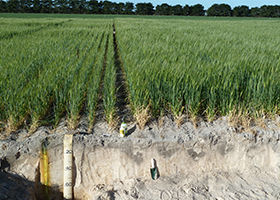Management of Soil Constraints to Improve Crop Performance in Water-Limited Environments
A special issue of Agronomy (ISSN 2073-4395). This special issue belongs to the section "Farming Sustainability".
Deadline for manuscript submissions: closed (31 March 2021) | Viewed by 21717

Special Issue Editors
Interests: managing water repellency; soil aluminium toxicity; soil acidity and nutrient deficiencies (sulfur, nitrogen and phosphorus)
Special Issue Information
Dear colleagues,
Management of soil constraints to improve crop performance in water-limited environments is the key to maintaining profitable and sustainable agriculture systems. Soil constraints include soil water repellency, soil aluminium toxicity or soil acidity, soil compaction (natural and induced), salinity, sodicity, boron toxicity and nutrient deficiencies. Soil water repellence affects crop establishment, especially when there is low and variable rainfall at the start of the growing season resulting in poor crop establishment. Subsoil aluminium toxicity, soil compaction, salinity, sodicity, boron toxicity and some nutrient deficiencies reduce root growth, thus limiting the ability of the crop to access water and nutrients. In soils amended to overcome constraints, it is important to adjust nutrient management practices to take advantage of improvements in nutrient use efficiencies and to address higher nutrient demand due to greater crop yield. Management practices are designed to overcome these soil constraint to crop production (grain yield) in water-limited environments where low and variable growing season rainfall has become more prevalent in recent years due to climate change.
This Special Issue aims to publish innovative studies demonstrating that managing soils with single or multiple constraints can increase the profitability and sustainability of the agricultural system in water-limited environments. We would like to invite you to contribute to this Special Issue by submitting reviews, case studies, research papers, and opinion articles on innovative approaches for overcoming soil constraints for crop production in water-limited environments. Manuscripts are invited from studies conducted on all water-limited environments, but especially from the rainfed cropping areas of the mediterranean and semi-arid tropical climates.
Dr. Geoff AndersonDr. Ed Barrett-Lennard
Guest Editors
Manuscript Submission Information
Manuscripts should be submitted online at www.mdpi.com by registering and logging in to this website. Once you are registered, click here to go to the submission form. Manuscripts can be submitted until the deadline. All submissions that pass pre-check are peer-reviewed. Accepted papers will be published continuously in the journal (as soon as accepted) and will be listed together on the special issue website. Research articles, review articles as well as short communications are invited. For planned papers, a title and short abstract (about 100 words) can be sent to the Editorial Office for announcement on this website.
Submitted manuscripts should not have been published previously, nor be under consideration for publication elsewhere (except conference proceedings papers). All manuscripts are thoroughly refereed through a single-blind peer-review process. A guide for authors and other relevant information for submission of manuscripts is available on the Instructions for Authors page. Agronomy is an international peer-reviewed open access monthly journal published by MDPI.
Please visit the Instructions for Authors page before submitting a manuscript. The Article Processing Charge (APC) for publication in this open access journal is 2600 CHF (Swiss Francs). Submitted papers should be well formatted and use good English. Authors may use MDPI's English editing service prior to publication or during author revisions.
Keywords
- water limited-environments
- water-limited yield potential
- root growth
- climate change
- climate variability
- weather/rainfall prediction
- drought
- soil constraints
- root depth
- water repellency
- aluminium toxicity or soil acidity
- salinity
- soil compaction
- nutrient management
- deep tillage
- deep ripping
- subsoil amendment
- mediterranean climate
- semi-arid tropics
- water use efficiency
- nutrient use efficiency
- sodicity
- boron toxicity






